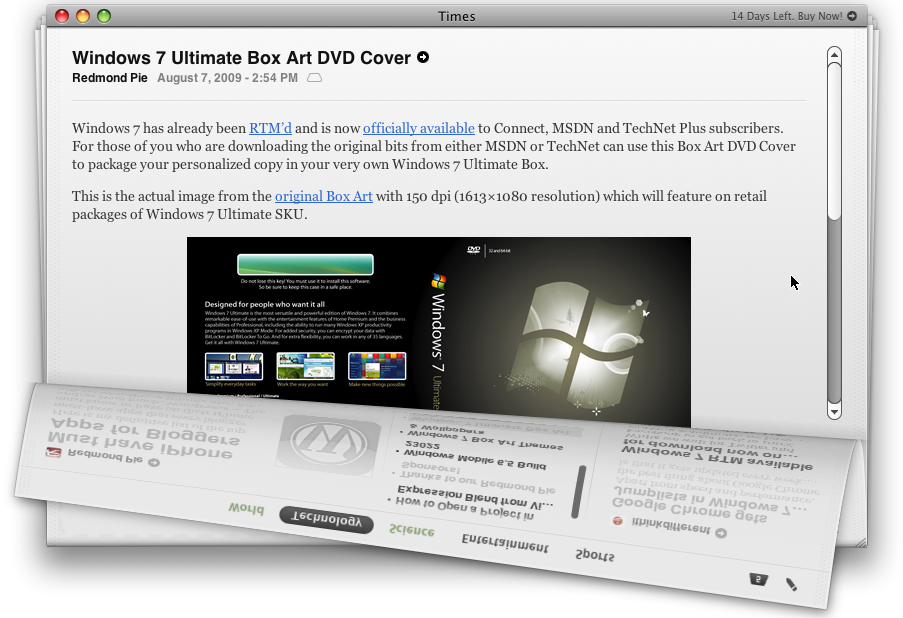Pipeline 2—Download and Installation
Menu
Prerequisites
CUCAT Olearia, an open-source DAISY reader for Mac OS X DAISY Book Reader, open-source player for the GNOME desktop (GTK) Daisy Delight: open-source player for DAISY 2.02, for Mac OS X and Unix-based systems daisy-player, an open source, multilingual, ncurses-based program for Linux to play DAISY books from the command line. Mac drive reader free download - Paragon NTFS for Mac, Drive Genius, Apple Mac OS Update 8.1, and many more programs.
EBook Reader for Mac OS v.1.0 An affordable digital book reader compatible with Intel Mac computers running Leopard (OS 10.5) or later. The User is assisted with downloading free eBooks and removing unnecessory characters. I had to choose between the new Mac Mini and an iMac Pro for iOS/Android software development. I've been using a 2012 Mini i7, and after retrofitting a 'fast' 1GB flash SATA drive (OCZ Vector 180, 400MB/sec) I've stretched it to it's limits, and will probably not get the next major OS upgrade. OS X only has a few disk space analyzers, and the good news is that they're all pretty good. Nonetheless, we feel Disk Inventory X is the way to go thanks to its organization, massive amount of.
Java
The application can be run on most common operating systems but it must run in a Java runtime environment. Windows and Mac users do not have to worry about Java because it is included in the DAISY Pipeline installation. Linux users must, however, make sure that Java is present. The minimum required version is Java is 11 We recommend installing Java from Adopt Open JDK.
JavaFX
The desktop application requires JavaFX. If you are on Windows or Mac, a version of Java that includes JavaFX, namely Oracle’s Java SE implementation, is automatically installed for you. If you are on another platform and can not use Oracle’s Java, have a look at the following alternatives for acquiring JavaFX:
- Debian/Ubuntu—https://packages.qa.debian.org/o/openjfx.html
- Mobile and embedded—http://gluonhq.com/labs/javafxports/
- JavaFX can be built from source—https://wiki.openjdk.java.net/display/OpenJFX/Main
Download
Latest Official Version: 1.12.1
This includes the standalone desktop application, the server, and the command line interface. Versions are available for:
- DAISY Pipeline 2 for Windows (.exe file, 104 MB)
- DAISY Pipeline 2 for Mac OS X (.dmg file, 138 MB)
- DAISY Pipeline 2 for Linux (.zip file, 83 MB)
- DAISY Pipeline 2 for Debian/Ubuntu (.deb file, 78 MB)
Latest Web UI: 2.7.0
- For Windows users (.msi file, 54 MB)
- For Debian/Ubuntu users (.deb file, 51 MB)
- For Red Hat/CentOS users (.rpm file, 54 MB)
Installation
Windows
For Windows users the Windows installer automatically installs the desktop application, the server and the command line tool. Simply launch the installer and follow the instructions on the screen.
Mac OS
For Mac OS users the disk image contains the desktop application. To install, open the image and drag the application file to your Applications folder.
Debian
Users of Debian or Debian-based distributions such as Ubuntu can install DAISY Pipeline via the ZIP file, but it may be easier to use the Debian package manager.

- Open a shell window
- Change to the directory where you have downloaded the DEB file
- Execute the command—dpkg -i daisy-pipeline2_x.y.z.deb
The Debian package includes the desktop application, the server and the command line tool.
Red Hat
Users of Red Hat or other RPM-based distributions can install DAISY Pipeline via the ZIP file, but it is easier is to use the YUM package manager.
- Open a shell window
- Change to the directory where you have downloaded the RPM file
- Execute the command—yum install daisy-pipeline2_x.y.z.rpm
The RPM package includes the desktop application, the server and the command line tool.
Daisy Reader For Mac Os 10.10
Linux (ZIP)
The ZIP can be installed on all Linux distros. It includes the desktop application, the server and the command line tool. To install, simply extract the contents to any destination you want.
Docker
The Docker distribution is not available as a download on the website. It comes in the form of a Docker image that you can obtain via the Docker command line interface—docker pull daisyorg/pipeline-assembly
It is also possible to get a specific version—docker pull daisyorg/pipeline-assembly:<version>
You can find the available versions at https://hub.docker.com/r/daisyorg/pipeline-assembly/tags. To learn more about Docker see https://docs.docker.com.
Updater
Some packages also include an updater tool that you can use for quickly updating your current installation to the latest version. The updater can be invoked either via the desktop application or via the command line. The desktop application has a menu item Check Updates under Help. On the command line it is different for each platform.
Pipeline 2—Download and Installation
Menu
Prerequisites
Java
The application can be run on most common operating systems but it must run in a Java runtime environment. Windows and Mac users do not have to worry about Java because it is included in the DAISY Pipeline installation. Linux users must, however, make sure that Java is present. The minimum required version is Java is 11 We recommend installing Java from Adopt Open JDK.
JavaFX
The desktop application requires JavaFX. If you are on Windows or Mac, a version of Java that includes JavaFX, namely Oracle’s Java SE implementation, is automatically installed for you. If you are on another platform and can not use Oracle’s Java, have a look at the following alternatives for acquiring JavaFX:
- Debian/Ubuntu—https://packages.qa.debian.org/o/openjfx.html
- Mobile and embedded—http://gluonhq.com/labs/javafxports/
- JavaFX can be built from source—https://wiki.openjdk.java.net/display/OpenJFX/Main
Download
Latest Official Version: 1.12.1
This includes the standalone desktop application, the server, and the command line interface. Versions are available for:
- DAISY Pipeline 2 for Windows (.exe file, 104 MB)
- DAISY Pipeline 2 for Mac OS X (.dmg file, 138 MB)
- DAISY Pipeline 2 for Linux (.zip file, 83 MB)
- DAISY Pipeline 2 for Debian/Ubuntu (.deb file, 78 MB)
Latest Web UI: 2.7.0
- For Windows users (.msi file, 54 MB)
- For Debian/Ubuntu users (.deb file, 51 MB)
- For Red Hat/CentOS users (.rpm file, 54 MB)
Installation
Windows
For Windows users the Windows installer automatically installs the desktop application, the server and the command line tool. Simply launch the installer and follow the instructions on the screen.
Mac OS
For Mac OS users the disk image contains the desktop application. To install, open the image and drag the application file to your Applications folder.

Debian
Users of Debian or Debian-based distributions such as Ubuntu can install DAISY Pipeline via the ZIP file, but it may be easier to use the Debian package manager.
- Open a shell window
- Change to the directory where you have downloaded the DEB file
- Execute the command—dpkg -i daisy-pipeline2_x.y.z.deb
The Debian package includes the desktop application, the server and the command line tool.
Red Hat
Users of Red Hat or other RPM-based distributions can install DAISY Pipeline via the ZIP file, but it is easier is to use the YUM package manager.
- Open a shell window
- Change to the directory where you have downloaded the RPM file
- Execute the command—yum install daisy-pipeline2_x.y.z.rpm
The RPM package includes the desktop application, the server and the command line tool.
Linux (ZIP)
The ZIP can be installed on all Linux distros. It includes the desktop application, the server and the command line tool. To install, simply extract the contents to any destination you want.
Docker
The Docker distribution is not available as a download on the website. It comes in the form of a Docker image that you can obtain via the Docker command line interface—docker pull daisyorg/pipeline-assembly
It is also possible to get a specific version—docker pull daisyorg/pipeline-assembly:<version>
You can find the available versions at https://hub.docker.com/r/daisyorg/pipeline-assembly/tags. To learn more about Docker see https://docs.docker.com.
Free Mac Os For Windows
Updater
Daisy Reader For Mac Os High Sierra
Some packages also include an updater tool that you can use for quickly updating your current installation to the latest version. The updater can be invoked either via the desktop application or via the command line. The desktop application has a menu item Check Updates under Help. On the command line it is different for each platform.